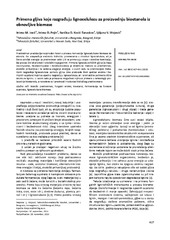Приказ основних података о документу
Application of lignocellulolytic fungi for bioethanol production from renewable biomass
Primena gljiva koje razgrađuju lignocelulozu za proizvodnju bioetanola iz obnovljive biomase
| dc.creator | Jović, Jelena M. | |
| dc.creator | Pejin, Jelena | |
| dc.creator | Kocić-Tanackov, Sunčica | |
| dc.creator | Mojović, Ljiljana | |
| dc.date.accessioned | 2021-03-10T12:38:25Z | |
| dc.date.available | 2021-03-10T12:38:25Z | |
| dc.date.issued | 2015 | |
| dc.identifier.issn | 0367-598X | |
| dc.identifier.uri | http://TechnoRep.tmf.bg.ac.rs/handle/123456789/2886 | |
| dc.description.abstract | Pretreatment is a necessary step in the process of conversion of lignocellulosic biomass to ethanol; by changing the structure of lignocellulose, enhances enzymatic hydrolysis, but often it consumes large amounts of energy and/or needs an application of expensive and toxic chemicals, which makes the process economically and ecologically unfavourable. Application of lignocellulolytic fungi (from the class Ascomycetes, Basidiomycetes and Deuteromycetes) is an attractive method for pre-treatment, environmentally friendly and does not require the investment of energy. Fungi produce a wide range of enzymes and chemicals, which, combined in a variety of ways, together successfully degrade lignocellu- lose, as well as aromatic polymers that share features with lignin. On the basis of material utilization and features of a rotten wood, they are divided in three types of wood-decay fungi: white rot, brown rot and soft rot fungi. White rot fungi are the most efficient lignin degraders in nature and, therefore, have a very important role in carbon recycling from lignified wood. This paper describes fungal mechanisms of lignocellulose degradation. They involve oxidative and hydrolytic mechanisms. Lignin peroxidase, manganese peroxidase, laccase, cellobiose dehydrogenase and enzymes able to catalyze formation of hydroxyl radicals (•OH) such as glyoxal oxidase, pyranose-2-oxidase and aryl-alcohol oxidase are responsible for oxidative processes, while cellulases and hemicellulases are involved in hydrolytic processes. Throughout the production stages, from pre-treatment to ferment-ation, the possibility of their application in the technology of bioethanol production is presented. Based on previous research, the advantages and disadvantages of biological pre-treatment are pointed out. | en |
| dc.description.abstract | Predtretman predstavlja neophodan korak u procesu konverzije lignocelulozne biomase do etanola. On unapređuje enzimsku hidrolizu promenama u strukturi lignoceluloze, ali je često utrošak energije za predretman veliki i/ili se primenjuju skupe i toksične hemikalije, što proces čini ekonomski i ekološki nepogodnim. Primena lignocelulolitičkih gljiva (iz klasa Ascomycetes, Deuteromycetes i Basidiomycetes) je atraktivna metoda za predtretman, ekološki prihvatljiva i ne zahteva ulaganje energije. U ovom radu su predstavljeni mehanizmi razgradnje lignoceluloze pomoću gljiva. One proizvode širok spektar enzima i hemijskih supstanci kojima uspešno razgrađuju lignocelulozu, ali i aromatične polimere slične strukture ligninu. U ovom radu je prikazana mogućnost njihove primene u tehnologiji proizvodnje bioetanola, a navedene su i prednosti i nedostaci biološkog predtretmana. | sr |
| dc.publisher | Association of Chemical Engineers of Serbia | |
| dc.rights | openAccess | |
| dc.rights.uri | https://creativecommons.org/licenses/by-nc-nd/4.0/ | |
| dc.source | Hemijska industrija | |
| dc.subject | biological pretreatment | en |
| dc.subject | fungal enzymes | en |
| dc.subject | bioethanol | en |
| dc.subject | solid state fermentation | en |
| dc.subject | lignocellulosic biomass | en |
| dc.subject | biološki predtretman | sr |
| dc.subject | fungalni enzimi | sr |
| dc.subject | bioetanol | sr |
| dc.subject | fermentacija na čvrstom supstratu | sr |
| dc.subject | lignocelulozna biomasa | sr |
| dc.title | Application of lignocellulolytic fungi for bioethanol production from renewable biomass | en |
| dc.title | Primena gljiva koje razgrađuju lignocelulozu za proizvodnju bioetanola iz obnovljive biomase | sr |
| dc.type | article | |
| dc.rights.license | BY-NC-ND | |
| dc.citation.epage | 641 | |
| dc.citation.issue | 6 | |
| dc.citation.other | 69(6): 627-641 | |
| dc.citation.rank | M23 | |
| dc.citation.spage | 627 | |
| dc.citation.volume | 69 | |
| dc.identifier.doi | 10.2298/HEMIND140916086J | |
| dc.identifier.fulltext | http://TechnoRep.tmf.bg.ac.rs/bitstream/id/949/2883.pdf | |
| dc.identifier.scopus | 2-s2.0-84953305757 | |
| dc.identifier.wos | 000369523000005 | |
| dc.type.version | publishedVersion |

